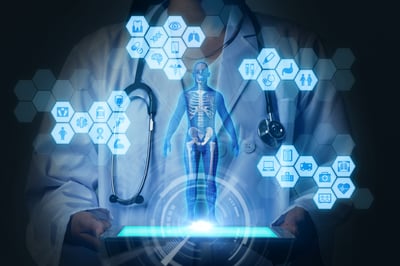July 31, 2025
.png?width=400&height=150&name=Copy%20of%20G2%20Image%20(1).png) by Shreya Mattoo / July 31, 2025
by Shreya Mattoo / July 31, 2025

No medical invention has been able to solve a root anomaly completely, reducing the sensation of a prick or pain during surgical procedures. But as every industry has now turned to artificial intelligence to pilot new methods of innovation, medical and healthcare are not just discovering painless treatments but also speedy patient recovery. Methodologies like nanobots, powered with machine learning operationalization software, are now being used to treat terminal ailments like leukaemia and offer painless immunotherapies.
By automating programs and powering nano devices, nanobots can provide painless drug delivery. Let's learn more about nanobots in detail.
Nanobots are nanoscale machines (1–100 nm) engineered from advanced materials to perform precise tasks inside the human body. Built for precision medicine, they can detect, diagnose, and treat diseases at the cellular level. Guided by external stimuli such as magnetic fields, heat, or light and advanced algorithms including AI, they enable targeted actions like drug delivery, cellular repair, and biosensing.
Nanobots, or nano robots, are microbots that are indeed real and measurable, but they are not visible to the naked eye. Measuring between 50 and 100 nanometers, they are smaller than one-hundredth the width of a human hair. Despite their minuscule size, nanobots can transmit electrical signals from an external computer to our organs, guided by relevant training data.
These remarkable machines can navigate through our bodies seamlessly, akin to tiny drug carriers. They follow the principle of "inertia precedes viscosity" to locate specific cells and identify any anomalies. Additionally, nanobots can serve as autonomous surgical assistants, performing procedures without human intervention.
Scientists always had a "nano-perception" towards inventions.
Medical science was the first industry to discover and implement nanobots for human and brain imaging. Other sectors, such as mining, construction, industrial safety, electronics, and automotive, implemented nanotech much later, mainly to automate time-bound and industrial safety tasks.
For many years, the advancement and conceptualization of nanobots were the sole purview of science fiction and academic theory. However, recent innovations have brought writers' contemplations to life, as seen in the physicist Richard Feynman's research in the 1960s.
While delivering his speech, "Plenty of Room in the Bottom", Dr. Feynman touched on the topic of nanoscience in medicine. He spoke about ways in which the derivatives and hybrids of nanoparticles can act as excellent drug delivery, AI biosensing, and molecular computation.
Later, in 1986, K. Eric Drexler wrote the book "Engines of Creation" in which he specifically pointed out how nanobots work well in response to environmental changes. He broke down the structure of a functional nanobot device into switches, sensors, and motors that detected diseases of the human body. He also defined nanobots as complex, but human-friendly gadgets that can break the infectious supply of germs.
Nanobots need to be compatible with the kind of external energy they receive. If you want nanobots to emit magnetic energy, you have to charge them before using electromagnetism. For light substitutes, nanobots are carved out of metal, which is an excellent reflector of light. Carbon and iron are usually used to design nanobots, as they are malleable and biodegradable.
Compatible software, mainly a supervised machine learning algorithm, is necessary for nanobots to work accurately. Such software data models can help design biosensors that detect obstacles in the range of over 1 mm.
Ribosomes are the classic example of biological machines at the nanoscale
Sub-parts of a nanobot include:
The surface of nanorobots may be chemically processed to enhance stability, solubility, and biocompatibility properties or to give the ability to detect variations in the surrounding environment’s status.
Scientists are currently working to build conventional robots at the scale of nanobots. However, roboticists who want to create fully autonomous machines in the human body face severe challenges.
As nanobots operate on a microscopic scale, it’s crucial to have a professional carry out the entire process. Nanobots are a form of nanotechnology that forms the crux of many recent inventions, like self-driven cars, security tracking systems, intelligent window cleaning, and robotic vacuum cleaning.
Did you know? According to AZO Nano, a group of researchers recently found a novel ZnO-SiO2 nanopowder that detects fingerprints on various surfaces – dry and wet. This nanopowder displayed the prints in detail, which helped track suspects.
Some types of nanobots include:
Fun fact: Ohio State University students use "DNA origami" to construct nanomachines that will eventually create efficient robots!
Source: SpringerLink
Nanobots, xenobiotics, and robots are all derivatives of nanotechnology that cater to different purposes. While various industries use nanobots and xenobiotics, exploring other applications to design future robots might take a while.
-png.png?width=600&height=333&name=Copy%20of%20X%20vs%20Y%20vs%20Z%20(6)-png.png)
Nanobots are artificially produced microscopic systems that can receive, process, and transfer information in response to an external energy stimulus. With less energy consumption and more throughput, nanobots surpass any conventional methods of biomedical applications.
In addition to healthcare, nanotechnology has helped many business spheres speed up their design, testing, and cleaning processes without any manual intervention.
Robots are post-fabricated versions of nanobots that automatically execute tasks based on human commands or gestures. A successful use case of robots is robotic vacuum cleaners, which use object detection to move around your house, clean floors, and collect garbage.
Robots are generally manipulated by an external control device, enabling them to complete all tasks in less time than humans.
Xenobiotics are micro-sized systems, devices, or living organisms programmed to perform some desired action. Currently, xenobiotics are found in antibiotics that kill viruses.
The nanobots we have access to today function by responding to external stimuli, such as chemical reactions, temperature, or radio waves.
Before understanding the working principle of nanobots, you must understand that nanobots are a technology of the future, not the present. Though we've entered an era of digital transformation, it will still take time, resources, and money to bring nanobots into force globally.
Below are some of the primary forms that nanobots can take with today's technology:
Nanobots switch their function from an "off" position to an "on" position through conformational changes in a machine. Nanobots have mechanical switches, similar to switching on or off a fan. These switch functions enable nanobots to self-assemble and accomplish their necessary tasks.
Tip: A conformational change happens when a nanobot changes its shape in response to the external energy source.
Using temperature, UV light, or chemical reactions, scientists can force these nanorobotic switches into specific positions to accomplish a task.
A nanomotor or micromotor is more complex than a nanorobotic switch and can use external energy to generate physical movement in the surrounding molecules.
A shuttle is a nano device that transports specific drugs or chemicals to a determined place. It is injected into a human vein to study patterns of blood tissues. Scientists are currently working to pair these with nanomotors so that there’s greater control over how they travel during vascular processes.
This is the most cutting-edge nanodevice: it looks like a conventional car, just really small. It has four wheels and can move independently in response to light or electricity. The trick is steering them in the right direction once they get going.
Nanorobotic cars are based on nanomotors. However, the propulsion of nanomotors needs greater control.
The eventual goal of these various nanorobotic components is to create collective nanomachines that work together to complete goals on a macro-scale, much like a group of ants moves objects or overcomes obstacles.
Nanobots are much tinier than human cells at a micrometer scale, which is one-millionth of a meter. They comprise multiple molecular systems that perform a specific action. For this reason, nanobots are employed widely in the oncology department of medical science to detect dangerous tumors and for cancer therapy. They could be programmed to repair specific diseased cells. They'd work in a way similar to antibodies in our natural healing processes
Nanobots are also used as blood thinners and oxygen suppliers. They can also produce oxygen singlets via X-rays and improve blood circulation for body parts that don't receive enough blood oxygen (e.g., eye, and heart muscles).
Unlike common drugs that must move through the entire body before reaching a particular cell, nanobots initially target the cell. Electric microchips within a nanobot can combine with human tissues during incisions to capture and monitor blood sugar levels in your system.
Nanobots are also used for smart vaccines, digital therapy, capsule endoscopy, and organ transplants.
Rapid nanobot improvements may sound like something straight out of a movie, but these innovations are a technological milestone. There are several ways in which these self-charged structures can benefit humankind, as mentioned as follows:
The ways to detect and power nanobots in a controlled and accurate way are:
Medical companies want to adapt nanobots into their pharmaceutical process to design better cures. However, it isn't as flowery as it seems. Blending complex algorithmic expressions with medical science is a tricky affair. But some high-level challenges stand in the way of a nano-powered future.
Nanobots are used in different fields of medicine and space exploration. In the automobile sector, they create lighter and more flexible engines. In the pharmaceutical industry, chemical molecules react in the presence of nano-energy to produce new medicines. Researchers are using their expertise to examine nanobots at every stage of the drug development pipeline to ensure no mistake occurs.
But there are even more nanobot medical breakthroughs for you to learn about!
Re-adjusting human DNA into specific two- and three-dimensional shapes through heating is known as DNA origami. Paul Rothemund was the first US scientist to develop a way to fold DNA into patterns and shapes of nanometers.
One of the best examples of how this works can be found in the work of the cancer-fighting nanobots developed by a Chinese roboticist in mid-2018. After injecting mice with human cancer cells, the roboticists used DNA origami to build nanobots which were later loaded with a blood-clotting drug intended to cut off the blood supply of the cancer cells.
Source: Research gate
Did you know? A medical breakthrough, cancer immunotherapy, uses nano-optogenetic engineering of CAR-T cells, which are created in a lab, to locate and destroy cancer. Roughly nine out of 10 people suffering from Lymphoblastic Leukemia underwent this treatment and came back in full remission.
Gene therapy is delivered through nanotechnology to treat muscular disorders. Nanobots are a form of theranostic device ( providing digital imaging of human cells) that can display the current condition of the affected muscles and what kind of replacement surgery they require.
Nanorobotics would be widely implemented in the future to replace expensive surgical procedures. Small nanodevices can travel inside our bodies to perform procedures, making them much faster and less painful.
Using nanobots as an effective mode of conducting surgeries will also reduce the chances of failure or rebound surgeries.
Smart vaccination is an intelligent nanobot technology that strengthens the human immune system. A great example is the Pfizer BioNTech COVID-19 vaccine, which uses iron nanoparticles to transport RNA molecules into the human body.
These nanoparticle delivery vehicles transfer the chemical load to our white blood cells (WBC). As the load gets transferred, the WBC makes proteins similar to the new coronavirus's spike structure, which enables them to identify and stop virus mutations.
Nanobots can be used to chemically test viruses and prevent the spread of diseases. They can be loaded with biosensors that act as little computers to capture the faintest hint of a deadly virus in no time. As the sensors interpret the virus, they transmit the electromagnetic signals back to the laboratory, which tests and confirms the presence of a virus.
The information is delivered via cloud computing to areas without the infrastructure or specific labs to alert the public.
Nanobots are microscopic machines, typically ranging from 1 to 100 nanometers in size. While invisible to the naked eye, they often resemble miniature robots with specialized parts — like sensors, propulsion tails (flagella), or payload capsules—designed for specific medical functions such as drug delivery, diagnostics, or cell repair.
Nanobots are being developed to detect, monitor, or treat diseases at the cellular level. Early applications include:
While nanobots don’t “cure” cancer in the traditional sense, they are making cancer treatment safer and more precise. For example, they can deliver chemotherapy directly to tumor cells, minimizing damage to healthy tissue. Some experimental nanobots are also being tested to cut off the blood supply to tumors or assist in early tumor detection, significantly enhancing treatment outcomes.
The lifespan of nanobots depends on their material composition and intended function. Biodegradable nanobots may dissolve within hours or days of completing their task, while others, especially those used for long-term diagnostics or monitoring, can remain active for weeks. Most medical nanobots are designed to exit or degrade safely to prevent accumulation.
Yes, though it is still in the early stages. Several nanobot platforms have reached human clinical trials, especially in cancer treatment and dental procedures. For example, Nanobiotix's NBTXR3 (a nanoparticle radioenhancer) has been used in European cancer patients. In India, Theranautilus is testing dental nanobots in root canal therapies. However, widespread commercial use is still in development.
Nanobots haven't been employed on a broad commercial scale, mostly because the horizon is still unexplored. Yet, experts reckon that it has the potential to win significant battles for humankind.
From self-healing to providing humans with night vision capabilities, nanobots could become the tiniest blessing in disguise for biotechnology success.
Discover how AI is revolutionizing healthcare. Learn about the latest advancements and innovations and their impact on patient care.
This article was originally published in 2022. It has been updated with new information.
Shreya Mattoo is a former Content Marketing Specialist at G2. She completed her Bachelor's in Computer Applications and is now pursuing Master's in Strategy and Leadership from Deakin University. She also holds an Advance Diploma in Business Analytics from NSDC. Her expertise lies in developing content around Augmented Reality, Virtual Reality, Artificial intelligence, Machine Learning, Peer Review Code, and Development Software. She wants to spread awareness for self-assist technologies in the tech community. When not working, she is either jamming out to rock music, reading crime fiction, or channeling her inner chef in the kitchen.
5G technology is set to take over the world and herald in a new age of the internet.
 by Hamna Amjad
by Hamna Amjad
It seems pretty straightforward: a physician prescribes medication, then the patient fills the...
 by Michele Daniels
by Michele Daniels
Medtech is becoming a trendy buzzword that might interest you, especially if you're trying to...
 by Robert Kazmi
by Robert Kazmi
5G technology is set to take over the world and herald in a new age of the internet.
 by Hamna Amjad
by Hamna Amjad
It seems pretty straightforward: a physician prescribes medication, then the patient fills the...
 by Michele Daniels
by Michele Daniels


